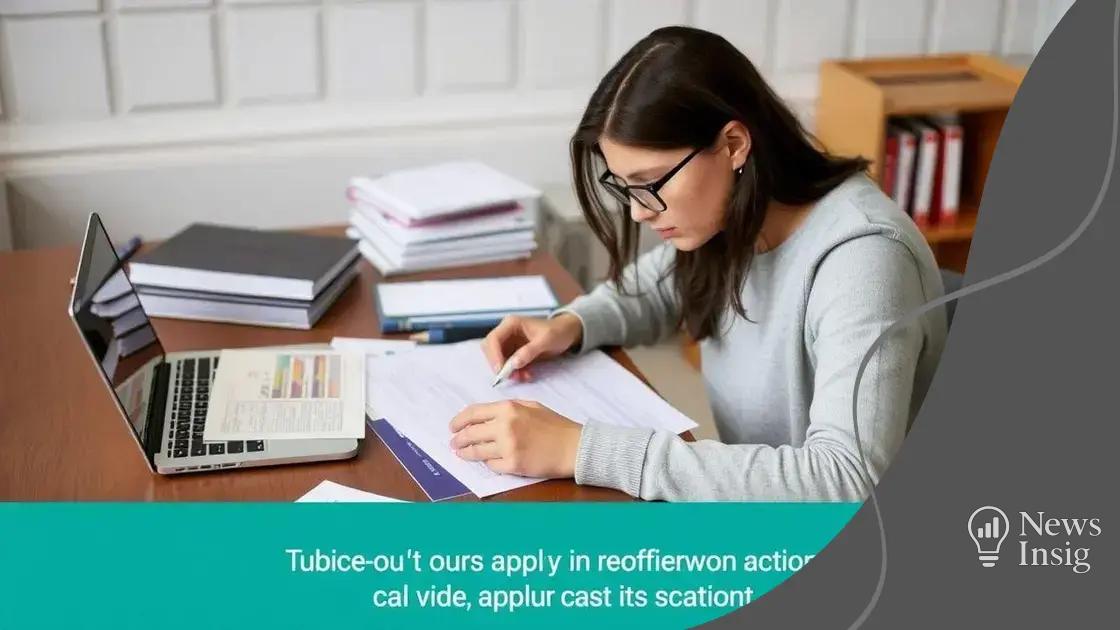Tuition assistance programs: Unlocking education for all

Anúncios
Tuition assistance programs provide financial support to students, enabling them to afford education through grants, scholarships, and employer-sponsored aid, ultimately improving their chances of graduation and career success.
Tuition assistance programs are designed to alleviate the financial burden of education, allowing more individuals to pursue their academic goals. Have you ever wondered how these programs can open doors for you or someone you know? Let’s dive into the details!
Anúncios
Understanding tuition assistance programs
Understanding tuition assistance programs can greatly impact your educational journey. These programs are crucial for making higher education more accessible and affordable for many.
Applicants often wonder what types of assistance are available. To help you navigate this, let’s break down the main features of tuition assistance programs.
Types of Tuition Assistance
Anúncios
There are several types of tuition assistance available, each catering to different needs. Whether you are a student, a parent, or a working professional, these programs can support your educational goals.
- Grants: Financial aid that doesn’t need to be repaid.
- Scholarships: Funds awarded based on merit or need.
- Employer-sponsored assistance: Many companies offer financial help for employees pursuing education.
- Federal and state aid: Government programs designed to support students financially.
Applying for these programs can seem overwhelming, but understanding the requirements can simplify the process. Typical eligibility criteria include financial need, academic performance, and enrollment status.
Many programs require you to fill out the Free Application for Federal Student Aid (FAFSA). This application assesses your financial situation to determine your eligibility for various types of assistance. It’s essential to complete this form accurately and on time.
Benefits of Tuition Assistance
Utilizing tuition assistance programs can lead to significant financial benefits. By minimizing the cost of your education, you can graduate with less debt, allowing you to focus on your career rather than long-term student loans.
Furthermore, these programs often provide opportunities for networking and mentorship, connecting you with professionals in your field of study. Taking advantage of tuition assistance can pave the way for a successful academic and professional path.
Types of tuition assistance available
When exploring tuition assistance, understanding the different types available can help you find the right program for your needs. Knowing your options is the first step towards making education affordable.
Grants
Grants are a popular form of assistance. Unlike loans, grants do not need to be repaid. They are often awarded based on financial need, making them valuable for many students.
- Federal Pell Grants support low-income students.
- State grants assist residents and often have specific eligibility requirements.
- Institutional grants are provided directly by colleges and universities.
Scholarships are another excellent option. They can reward both academic excellence and special talents. Many organizations offer scholarships based on various criteria, such as sports, arts, or even community service.
Employer-Sponsored Tuition Assistance
Many employers offer tuition assistance as a benefit to their employees. This can significantly help those pursuing higher education while working.
- Some companies reimburse tuition costs after course completion.
- Others offer direct payment to educational institutions.
- This aid can apply to degree programs or professional development courses.
Federal and state aid programs also play a crucial role. These funds help students access education without incurring excessive debt. Each state has its own requirements and types of assistance.
It’s important to check your eligibility for various tuition assistance types. Awareness of the options available can lead to substantial financial savings and an enriched learning experience.
Eligibility criteria for tuition programs

Understanding the eligibility criteria for tuition programs is essential for anyone seeking financial aid for their education. Different programs have various requirements, so let’s break them down to help you navigate your options.
General Eligibility Requirements
Most tuition assistance programs require applicants to meet certain general criteria. These can include:
- Financial need: Many programs prioritize students with lower income.
- Enrollment status: You often need to be enrolled at least half-time in an accredited institution.
- Academic performance: Maintaining a minimum GPA can be necessary for many awards.
In addition, some programs may require specific documentation. You might need to submit tax forms, proof of income, or letters of recommendation as part of your application.
Types of Programs and Their Specific Criteria
Different types of tuition assistance programs have unique eligibility standards. Federal programs like Pell Grants often focus on financial need determined by the FAFSA. State grants might have residency requirements, while scholarships can be based on merit, special talents, or demographic factors.
For example, a scholarship for minority students might require proof of your background or participation in community service. On the other hand, employer-sponsored tuition assistance may depend on your tenure or performance with the company.
To avoid missing out on valuable funding, thoroughly research each program’s specific requirements and keep track of deadlines so you can apply properly.
How to apply for tuition assistance
Applying for tuition assistance can seem daunting, but understanding the steps involved can make the process smoother. First, it’s essential to gather necessary documentation to support your application.
Gathering Required Documents
Before you start your application, make sure you have the following documents ready:
- Identification: Keep your social security number or student ID handy.
- Financial records: This includes tax returns, W-2 forms, or pay stubs to demonstrate financial need.
- Enrollment information: Have details about your program, school, and enrollment status.
With your documents prepared, you can start filling out the application forms. The most common application for federal aid is the Free Application for Federal Student Aid (FAFSA). Completing this form accurately is crucial to determine your eligibility for various programs.
Completing the Application
When completing the FAFSA, ensure you fill out every section carefully. Provide information about your household income, assets, and the number of people in your household. Missing information can delay processing or result in ineligibility.
After submitting your application, keep track of deadlines for any specific programs you are interested in. Some may require additional forms or essays, so it’s essential to be proactive.
Once your application has been processed, you will receive a Student Aid Report (SAR). This document outlines your eligibility for financial aid. Review it carefully and reach out to your school’s financial aid office if you have questions.
Many state and private programs also offer their applications, so research additional funding options. Filling out these applications may require similar information, but they often have unique questions or requirements.
Success stories of tuition assistance programs
Success stories of tuition assistance programs highlight the profound difference these initiatives can make in students’ lives. Many individuals have transformed their futures by taking advantage of these opportunities.
Real-life Examples
Consider the story of Maria, who dreamed of becoming a nurse. Coming from a low-income family, she worried about affording college tuition. Through a local scholarship program, she received the financial aid she needed. With the help of this support, Maria completed her degree and is now working in a hospital, helping others in her community.
Another inspiring case is John, a single father juggling work and education. He applied for a federal grant that provided him with funding for his classes. This tuition assistance allowed him to pursue his degree without the burden of overwhelming debt. Today, John is a successful engineer and supports his family better than he ever imagined.
The Impact of Tuition Assistance
These stories reflect a larger trend. Numerous studies show that students who receive tuition assistance are more likely to complete their degrees and achieve better career outcomes. Programs provide not just financial help but also mentoring and networking opportunities, which can greatly enhance a student’s educational experience.
Additionally, many recipients of tuition assistance become advocates for others. They share their journeys and encourage fellow students to explore available resources. Their successes inspire others to take action, proving that financial challenges can be overcome with the right support.
The ripple effect of these success stories is significant. When individuals achieve their educational goals, it can uplift entire communities, leading to increased economic growth and improved living standards.
FAQ – Frequently Asked Questions About Tuition Assistance Programs
What are tuition assistance programs?
Tuition assistance programs help students pay for their education by providing financial aid or scholarships.
Who is eligible for tuition assistance?
Eligibility varies by program but often includes factors like financial need, enrollment status, and academic performance.
How do I apply for tuition assistance?
You can apply by filling out the FAFSA for federal aid, and researching specific state or private programs for their application processes.
What impact do these programs have on students?
Tuition assistance programs can significantly improve graduation rates and job prospects, enabling students to achieve their educational goals.





